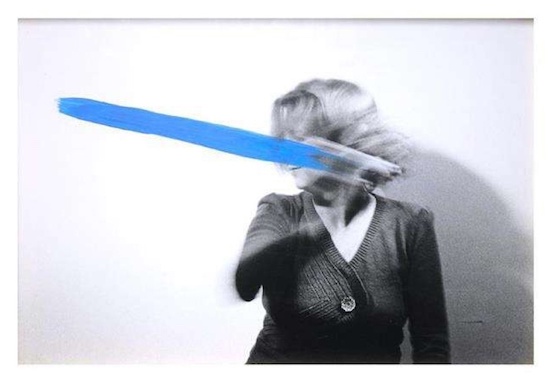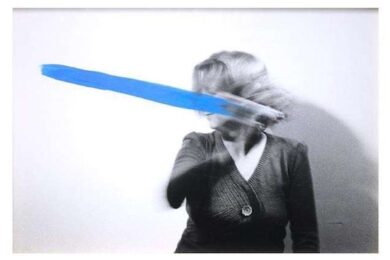Helena Almeida, Pintura Habitada, 1977/2007, Signed, numbered, and dated, Silkscreen print on paper, 50 x 70 cm, © The Artist; Courtesy Richard Saltoun Gallery, London
“My work is my body; my body is my work” this was the defining duality in Helena Almeida’s oeuvre and mind. She was a painter, photographer, performer, and video-artist, yet she could not be defined by any one single media. She used elements of each in her work alternatively, finding new exciting intersections between them. As João Ribas explained in an interview for Jeau de Paume, Almeida “worked in a variety of different ways in a variety of media almost confronting the limits of each and using them to overcome the limits of the other”.
In Tela Rosa para Vestir (Pink Canvas to Wear), from 1969, this is visible in the way she intersects performance, painting and space. Isabel Carlos, curator and one of the two critics (Peggy Phelan being the other) who Almeida considered to have a better understanding of her work than anyone else, commented:
“The canvas, the traditional vehicle of painting, is handled like a glove. Like when you take off a glove and look at it inside-out, the stitching and the cuts, and we can see in those works from the end of the 60s the stretcher bars and the work of carpentry that precedes it and the support of the canvas.”
I first saw Helena Almeida’s work when I was a teenager in Lisbon discovering the art collection at the Centro de Arte Moderna (Centre for Modern Art) in Gulbenkian. Later at art school, I would come to think of her as this figure sitting enshrined next to Paula Rego. So, last week, when I heard she had died I felt compelled to pitch an article about her to an international paper. I went around Lisbon, from Gulbenkian and to National Contemporary Art Museum of Chiado, seeing her work in person again, and I sat for hours in the library in Gulbenkian researching her work and life. I wanted to attempt to understand her work the way Isabel Carlos does and why so many people, particularly women, feel so connected to it.
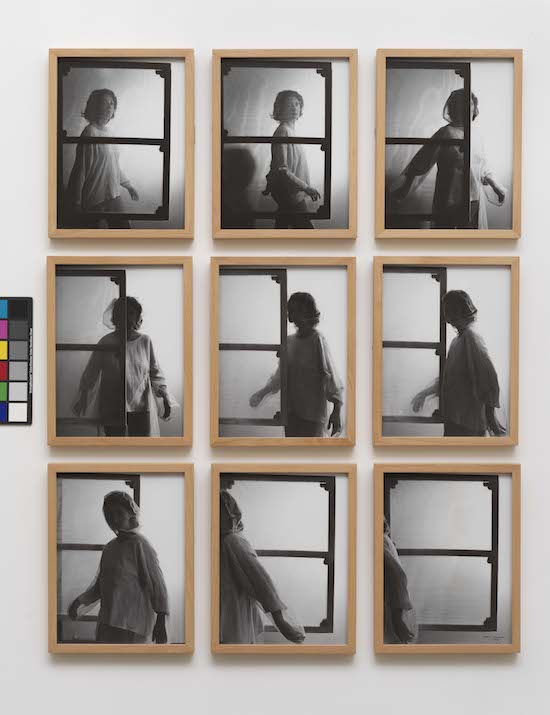
Helena Almeida, Inhabited Canvas, © Helena Almeida, currently on view at Tate Modern until 4 November 2018
Almeida’s story is tied to the social history of Portugal. Her father Leopoldo de Almeida was a sculptor, a significant part of his artwork was commissioned by the Estado Novo (the New State, the name for the period of the Dictatorship in Portugal from 1933 to 1974). During the regime, work was limited to whatever the government commissioned. Artists who opposed the dictatorship paid dearly, many, like Leopoldo de Almeida, who from a young age supported his mother, wife, three children, sister (a widow) and her children, had to make a living. Almeida’s relationship with her father defined her work. As a child, she would see him work and travel to international art shows with him.
In 1955, after finishing her Fine Art Painting degree at Escola Superior de Belas Artes, Almeida, by then married to Artur Rosa (architect and sculptor) with two young children, took time off to be with her babies. In 1964, she was awarded a Gulbenkian grant to go to Paris, she went to museums, galleries, met other artists, attended Francastel lectures at the Institut des Hautes Études, but above anything else, Almeida spent her time at the cinema – “I spent all day at the cinema. I watched all the films because they wouldn’t show them here – they wouldn’t at all, because of the dictatorship”. She wanted to be a filmmaker, and always regretted this had not come true. She once said “I remember when I saw The Purple Rose of Cairo, by Woody Allen, in the scene where the female character comes forth from the screen, I felt I could have done that. I thought: that is me”. Her fascination with film is evident in her work, her photographs and videos a cinematic quality to them, as is the case with Pintura Habitada (1976).
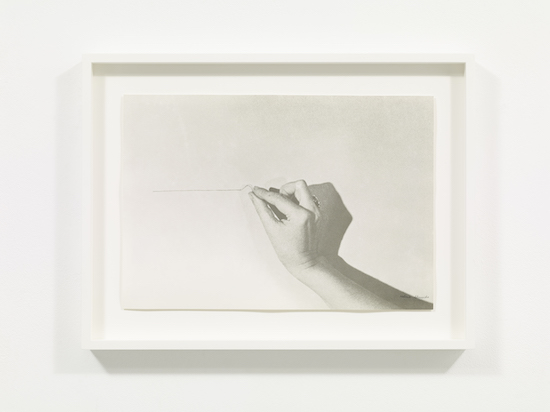
Helena Almeida, Sem Título (Untitled), 1975 Signed lower right, ‘Helena Almeida’, Black and white photograph, 28.7 x 41.5 cm © The Artist; Courtesy Richard Saltoun Gallery, London
Her early life and career were marked by the dictatorship’s repression. But they were also marked by an artistic influence – Lucio Fontana – whose work she saw at the Biennale in Venice. This moment changed the way she saw the canvas. Fontana, Spatialism’s founder, would paint canvases in solid luscious colours and then rip holes, challenging the canvas’s inherent bi-dimensionality. In an interview Almeida said:
“It was the hole, the obscure… What was the side he wanted me to see? Us to see? There were two spaces. It was not just the one. It was that beautiful red, luxurious, or that hole. What was the canvas? When I left there I was filled with ideas. I changed… then things started coming forth from the canvas. Then little by little I started to wear the canvas.”
Her early work was deeply influenced by these ideas, in her first solo show in 1967 at Galeria Buchholz in Lisbon she presented a canvas backwards. Later, in 1969 she takes this idea further with Tela Rosa para Vestir. This sense of breaking through space continued throughout her career and it is a defining element of her oeuvre.
Visually Almeida’s work changed from those early days, by the mid and late 70s her work was more sombre, more concise. Peggy Phelan even argues that “the photographs lack surface and bodily depth, suggesting that the artist’s body is merely a series of lines”. Understanding Almeida’s use of line is fundamental. Before making any piece, Almeida would draw. She used gesture line to great effect, the results are a delicate line that test shapes and borders (you can see examples of this at the Tate Modern). Drawing and sketching were for Almeida like “play”, this attitude present in the colourful notes of her studies. Just as important as line was colour, Almeida was appalled by any comparisons of the blue she used to Yves Klein’s – “he would squash women, which always shocked me” –, hers was a combination of cobalt and ultramarine blue. Red only started appearing later in her work at the time when her sister was dying of throat and tongue cancer – “I remember that she would bleed. Speaking with her and she would be there all fixed up, all neat, all made up and bleeding”.
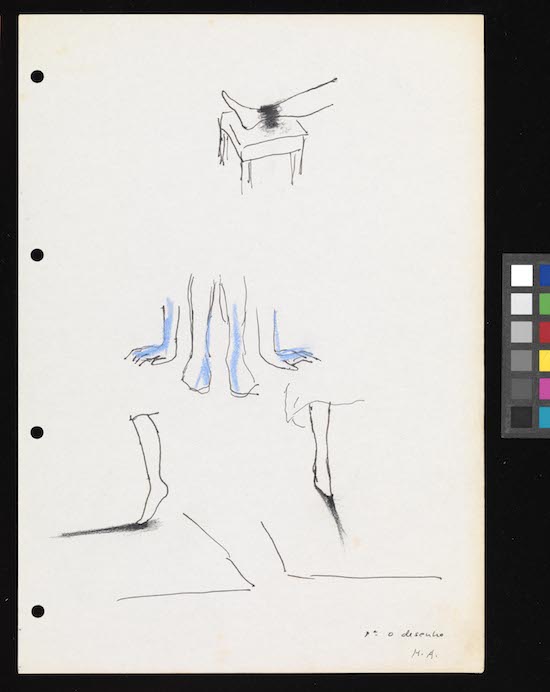
Helena Almeida, Drawing (with pigment), © Helena Almeida, currently on view at the Tate Modern until 4 November 2018
Tela Habitada (Inhabited Canvas) from 1976, also at the Tate Modern, is part of a series which is a more mature exploration of the relationship between space, art and the body. In this work, the artist appears stepping from behind a canvas, as she comes around the translucent cloth stretched in it envelops her. The result is fascinating, the canvas becomes a veil inscribing Almeida into art itself. Almeida appropriates both art and space in crossing the frontier between the media. But in this piece, there is another central issue: the representation of the female body as transgressive. As Peggy Phelan noted Almeida “traces some of what it might mean for women to be the body of art, rather than the object of art history’s narrow gaze”. Although Almeida never intended her work to be strictly feminist, she recognised the universality of the representation her body. She never wanted her work to be a series of self-portraits, they are auto-representations, Isabel Carlos unpacks this idea in her criticism: “since its [the body] representation (or image) does not possess the characteristics of a personality, nor the nature of the self-portrait”. (Over the course of the research I began to agree with Almeida, Carlos has an incredible understanding of her work)
I have always been fascinated by the idea of home. I think most people who emigrate are. Although Almeida lived in Lisbon all her life, she has an acute sense of this too: her home was her studio. In Experiência de Lugar II (Experience of Place II), Almeida walks on her knees through her studio carrying various objects in a sacrificial gesture. When Almeida was asked about this experience, particularly what had motivated her to go through such lengths of pain she said – “I think it was for love of my studio”.
It struck me reading this, that the studio which she so loved, was not just the space of all her creations. It was a space she shared with her husband Artur Rosa, who took all her photographs, and her father, while he was still alive. Indeed, this studio had been his, the space is therefore transmuted from simple workspace to “intimate space” (as Gaston Bachelard would put it). Moreover, in an interview, it becomes clear Almeida associated the space with discomfort and pain:
“I would model for my father since I was little, since I was 10 or 11 years old. When I didn’t have classes, I would go there. And it would give me immense pleasure to pose with the drapes… and the silence of the studio, the sound of the fireplace; my father did sculptures. And what I learned from him was a work schedule: how necessary it is to work, hours upon hours, in environments in which you have to stop feeling the body. The body does not exist and my body was also like that, it didn’t exist. I was there, still: I was a model, I couldn’t be cold or hot. And that was good.”
In Experiência de Lugar II Almeida recalls these experiences with her father, both of intimacy and protection, and pain. She recreates the nothingness of the body which her father had taught her she needed to be an artist. The studio becomes a symbol for a web of connections between Almeida, her father, husband, herself, art, the body, and her work.
Almeida wanted above all to “deal with emotions”, her work is a series of “emotions in photographic states”. The pieces she did with her husband Artur Rosa are perhaps the best examples of this need to express feelings. Until then he had been a backstage figure, taking all her photographs, but in works such O Abraço (The Hug), 2006, he appeared sharing the stage with Almeida. In the sequence, they appear in the middle of her studio sitting together on a precariously perched bench. In her own words, they appeared “holding each other desperately. Like there is a black hole around us. It’s really a black hole”. In this same interview Almeida seems to be already dealing with the inevitable ephemerality of her body and therefore, of her herself and her work, “one of us [Almeida and Rosa] will go sooner”.
Perhaps this article is self-indulgent, an excuse for me to delve into the life and work of an artist that defined my early experience of art. Perhaps you already knew these facts about her or reached the same conclusions regarding her work. If so then you are like me a “voyeur of Helena Almeida’s body”. I set out to discover why her work and life resonate with so many of us. I feel closer to an answer, but I think as with any artist or art there is not one reason. It’s hard not to fall into a cascade of clichés so I decided to give in to the temptation: her unwillingness to compromise with an unforgiving regime is admirable; her daring attitude in transgressing the boundaries of media is exciting and necessary to continue; her tenacity in finding new ways to represent the female body in art is exquisite. Helena Almeida’s passing should be an occasion to celebrate her work, and of other Portuguese artists of her generation, who have not had as much recognition as they should. I hope, at least, that my piece does this.
Helena Almeida 1934–2018. Works by Helena Almeida are currently on view at the Tate Modern, London

